This post may contain affiliate links. Please read our disclosure policy.

Everyone wants to make authentic, traditional (and not-so-traditional) Chinese dishes at home. The biggest complaint I hear when I post a Taiwanese or Chinese dish I’ve made is that you don’t want to go buy a bottle or jar or spice of this and that and only use it for one recipe and/or not sure how to use it for anything else.
I hear you on this! It’s frustrating and can be wasteful; which is why I’ve come up with this guide on the sauces and ingredients I keep in my cabinets and fridge at all times and how to use them to create multiple versatile sauces to be used in stir fries and noodle dishes.
Please keep in mind that this is what I personally keep in my cabinets and fridge. It may differ from another Chinese family. It is what I keep on hand because of what I find useful when I cook, and also what I’ve grown up with by watching my mom in the kitchen.
While I have you here, I want to draw awareness to culture. If you want to make a culturally important recipe, then you need the right ingredients otherwise you are not making that traditional food. It is one thing to have had the authentic dish before and you want to recreate it at home knowing that it’s likely not 100% accurate and (this is mostly for influencers) you don’t post your doctored up version online, but it’s another to never have had the dish before and remake it with some substituted or omitted ingredients. You may as well just not make it.
I’m sure this will rub people the wrong way and not everyone will agree and that’s fine. I know everyone is entitled to their own opinions as am I.
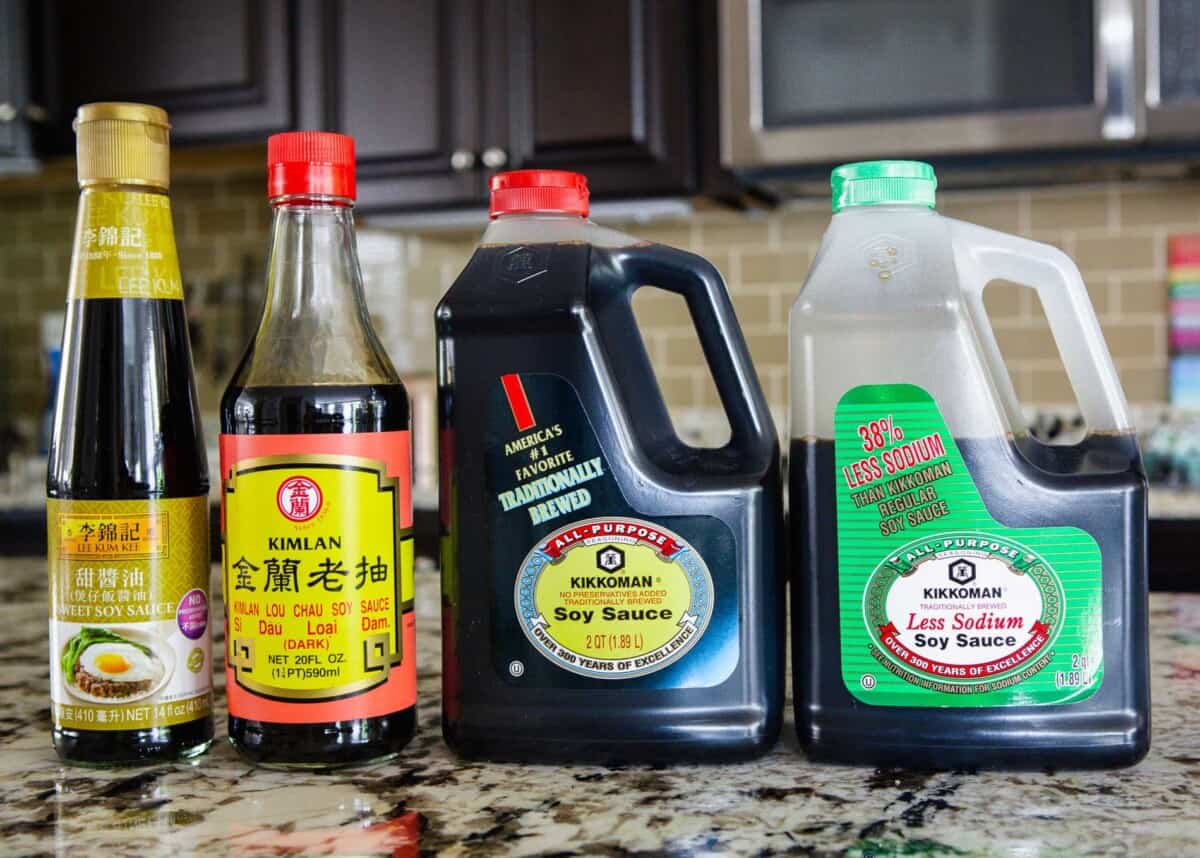
Soy Sauces
Soy sauce is soy sauce, right? Wrong. You’re going to be shocked at the variety of soy sauces out there. Just like there’s a variety of hot sauces, there is a variety of soy sauces.
Regular soy sauce
The standard soy sauce that you see in stores, but they are not all created equal.
If you’re at a traditional American grocery store, they most likely have Kikkoman (as seen pictured above) – which a great brand of soy sauce and I recommend it because it’s easy to find and they sell it in large jugs at Costco. It has decent flavor and honestly, just works for your basic Asian cooking.
When I go to the Asian market, I typically reach for Chinese or Japanese brand soy sauces. To me, they just have the most rich flavor and more depth to it. I will be honest with you, I never buy American store brand soy sauce. It’s just inauthentic to me.
If you buy soy sauce at the Asian market, they typically don’t label it “regular soy sauce” – you may see it labeled as simply “soy sauce.” Unless it’s low sodium, and says so, it’s just regular.
Low sodium soy sauce
This speaks for itself. It’s lower in sodium and what I use the most in my kitchen. I like being able to adjust salt content myself and typically you don’t really need the sodium levels of regular soy sauce to achieve what you are making.
Like I said above, in Asian markets, you’ll see “soy sauce” and then “low sodium soy sauce” or “light soy sauce.” Light soy sauce is basically the same as low sodium soy sauce. So unless it’s labeled as such, you can pretty much assume you are getting regular soy sauce. Confusing, huh?
Dark soy sauce
This is my favorite soy sauce to use. It’s dark and very rich in color. You would think that dark soy sauce is saltier but it’s actually not. Dark soy sauce is thicker, darker and less salty than regular soy sauce. It gives noodle and rice dishes that rich brown color that you see when you order at restaurants.
My mom used this most often for marinating. I use this in combination with low sodium soy sauce when I make sauces.
Sweet soy sauce
This is another favorite of mine. It’s sometimes hard to find at Asian markets but even harder to find at regular grocery stores.
If you guys can’t find this, I typically tell you guys to replicate it by adding a bit of dark brown sugar into your sauce.
I really like using sweet soy sauce because I love sweet and salty flavors and it really helps bring out the depth of the sauces I make. Of course, I don’t use this if I’m already adding honey or another sweetener to my sauces.
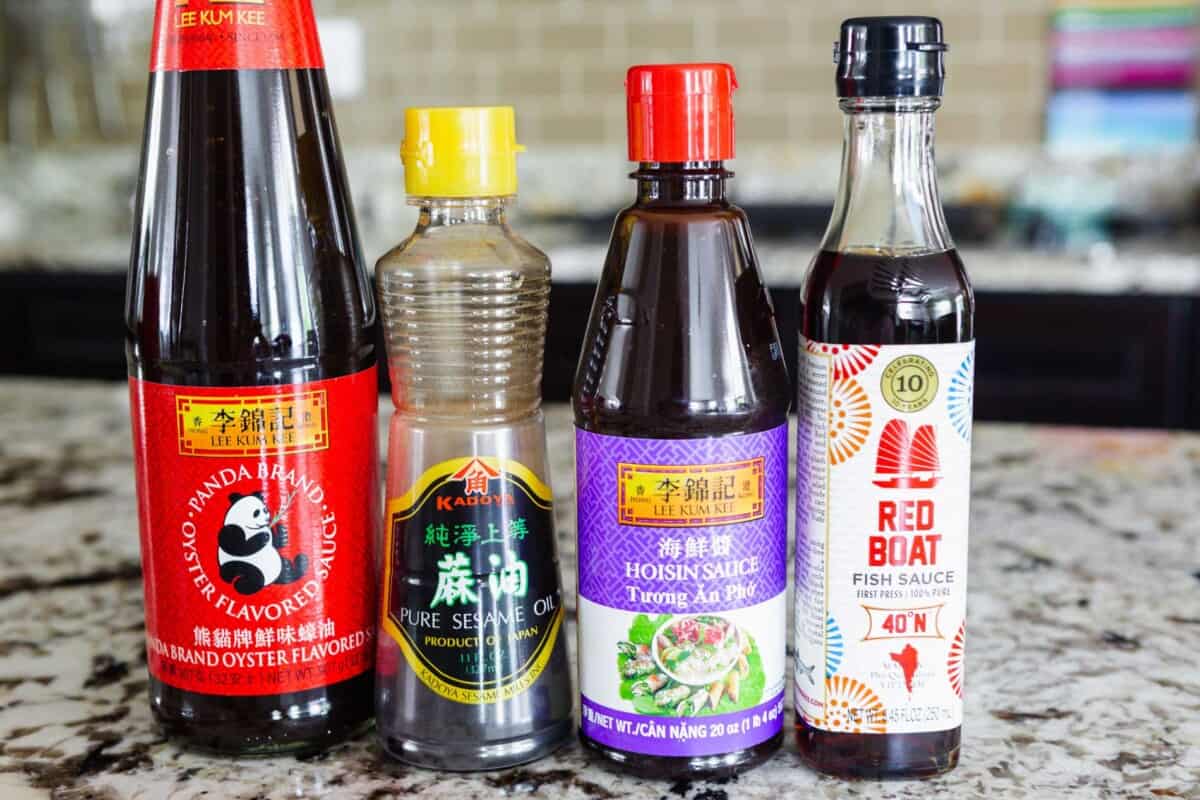
Other sauces/oils
Sesame oil
Sesame oil is an incredibly aromatic and tasty oil that most Asians have in their cabinets. The brand you see in the photo above, Kadoya, is the one I always get because it’s the one my mom always had in her kitchen. I also like it because it’s already toasted. You can tell by the rich amber/brown color.
They even have black sesame oil which is even richer and darker in color but that also means richer flavor. I usually never have black sesame oil on hand because I don’t find a use for it. Regular toasted sesame oil is just fine for every day use.
When cooking or making sauces with sesame oil, you have to be really careful because it’s pretty strong. It can easily overpower a dish if you use too much of it. It also has a high smoke point so you never want to directly add it to your hot skillet to cook with it. You usually add it into sauces or as a finishing oil
Hoisin sauce
Hoisin sauce is most typically known for when you go to a Peking duck restaurant and slather that all over your tortilla. It’s often given to you as a condiment at Pho restaurants.
I sometimes use hoisin sauce in my sauces because it gives it a sweet and savory flavor. It’s a thicker sauce and it’s made out of soybeans. I personally don’t really taste the soybeans in it but I taste more of a semi-sweet, savory, and a little nutty background flavor. It’s really hard to describe the taste to you, and it’s just something you have to taste for yourself.
I put it in my sauces because it can help bring out even more flavor in addition to what is already in it.
Fish sauce
Okay so fish sauce — you either love it or hate it. Kind of like anchovies, honestly. For the longest time, I didn’t realize that my favorite soup, Tom Yum, had fish sauce in it and the fish sauce was what I loved about it, haha. When I found out it was fish sauce, I was like wow, I really do love fish sauce!
If you aren’t a fish fan, I doubt you will like this, but man, it really gives great umami to a lot of sauces. You don’t use a lot at all, more often than not it’s like 1 teaspoon, and that really goes a long way. I have started to use fish sauce in a lot more sauces and dishes and it really elevates the dish.
The brand that is pictured above is the best in terms of flavor (personal opinion) but it is also becoming more readily available in regular grocery stores.
Oyster sauce
This is another sauce that you’ll love or hate but I have always loved oyster sauce because the flavor is just SO GOOD. I would dip meats in it growing up, lol
Even though the name says it’s ‘oyster sauce,’ it actually tastes nothing like oysters. It’s a very thick sauce and I honestly hate the bottle it comes in. It’s like the glass Heinz ketchup bottle where you have to smack it so hard to get anything out of it. However, the bottle photographed above is the one I always have in my kitchen because my mom always had that one in her kitchen, and I think it’s the most common brand you see at the store. It’s hard to miss because it has a panda on it!
It’s another one of those sauces that you don’t need a lot of but when you do use it, it packs a huge umami flavor and can really amplify your sauce. When in doubt, put in oyster sauce is what I usually say.
I have gotten the question on a vegetarian oyster sauce substitute numerous times over the years and I think manufacturers have gotten the same because they now make a vegetarian oyster sauce. I personally haven’t bought it so I don’t know how close the flavor is to regular oyster sauce, but I presume it’s similar.
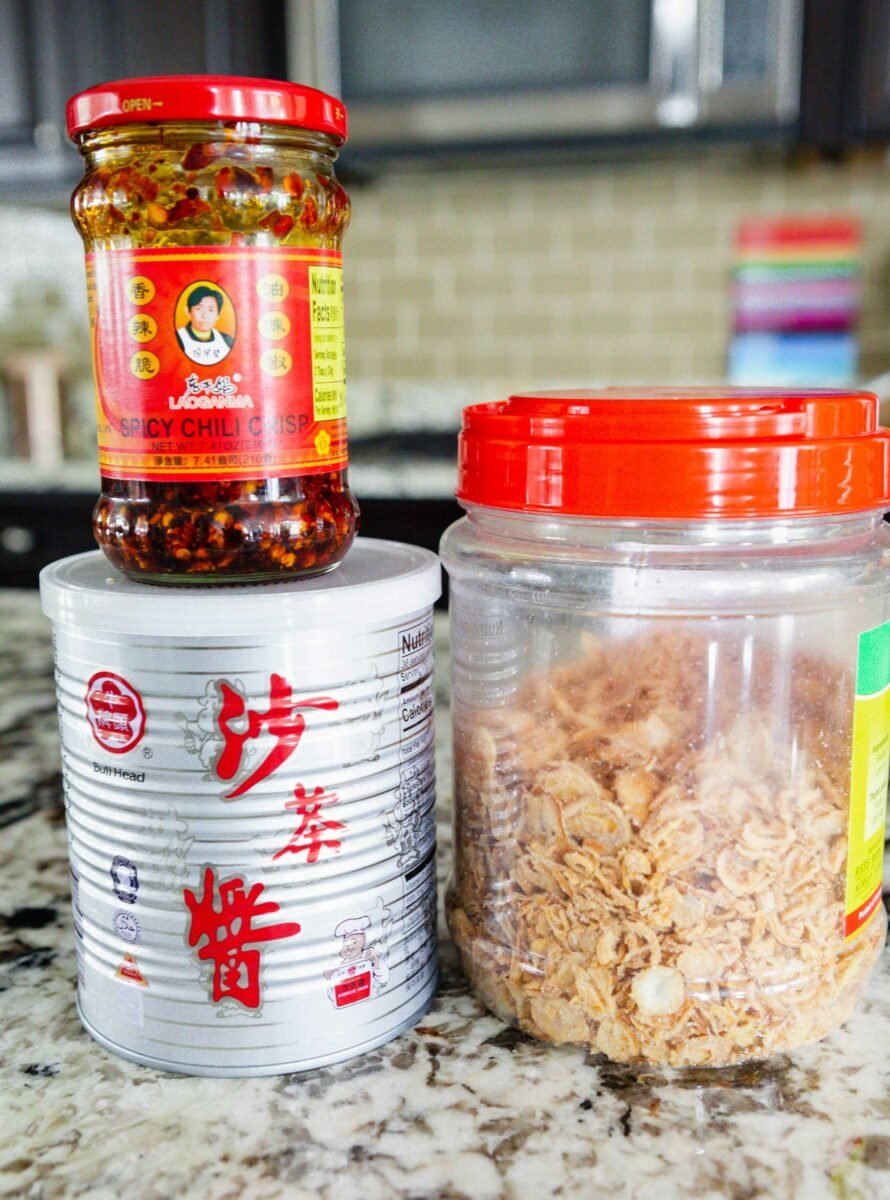
Sacha sauce
We call this Chinese BBQ sauce but it’s anything but traditional BBQ sauce that you think of when it comes to flavor.
The Bullhead brand, as pictured, is probably the most common can that you will see in any Chinese person’s fridge. I feel it’s like a right of passage to have a can in your fridge, lol…like we ALWAYS had it in the fridge growing up.
It’s an extremely versatile and tasty sauce. We most often used it in hot pot and also as a dipping sauce on the side, but it’s also so easy to use to make meat dishes or even noodle dishes. A giant spoonful of it in a dish can just be a sauce itself and creates so much flavor because of what’s in it. There’s shallots, garlic, dried fish, oil, sesame, spices. It’s a very unique flavor that again, hard to describe and one I highly suggest you giving a try!
It’s kind of messy so we always had it on a paper towel in the fridge, and it’s one of those sauces you stir to mix. Kind of like natural peanut butter!
Sambal Oelek and Chili Garlic Sauce
The iconic green topped jar sauce. It’s readily available and I always have a big jar of it in the fridge.
It’s an all-purpose sauce and I will add it to sauces all the time to give it a little spicy, flavorful kick.
There’s also another variety from the same brand and same jar but named chili garlic sauce. They’re different in that there is garlic in the chili garlic sauce and it has more seasonings. It’s not as spicy as Sambal Oelek.
Sriracha
I think everyone by now knows what sriracha is and of course, as of writing (6/23/2022) there is a massive shortage.
Let me reiterate, sriracha is not a replacement for hot sauces in dishes. You don’t assume that sriracha can replace chili garlic sauce in a dish or sriracha can replace chili oil in a dish. It’s an entirely different class of flavor just kind of like ketchup can’t replace marinara sauce.
I know that a lot of people think this because over the years, sriracha has gained a huge market in the non-Asian community, but you also have to understand the root of it (like the flavor) and you can’t just use it to replace an ingredient.
That said, I love using sriracha as a hot sauce topping on my noodle dishes but I’ve also squirted a teaspoon or two in my sauces. It just depends!
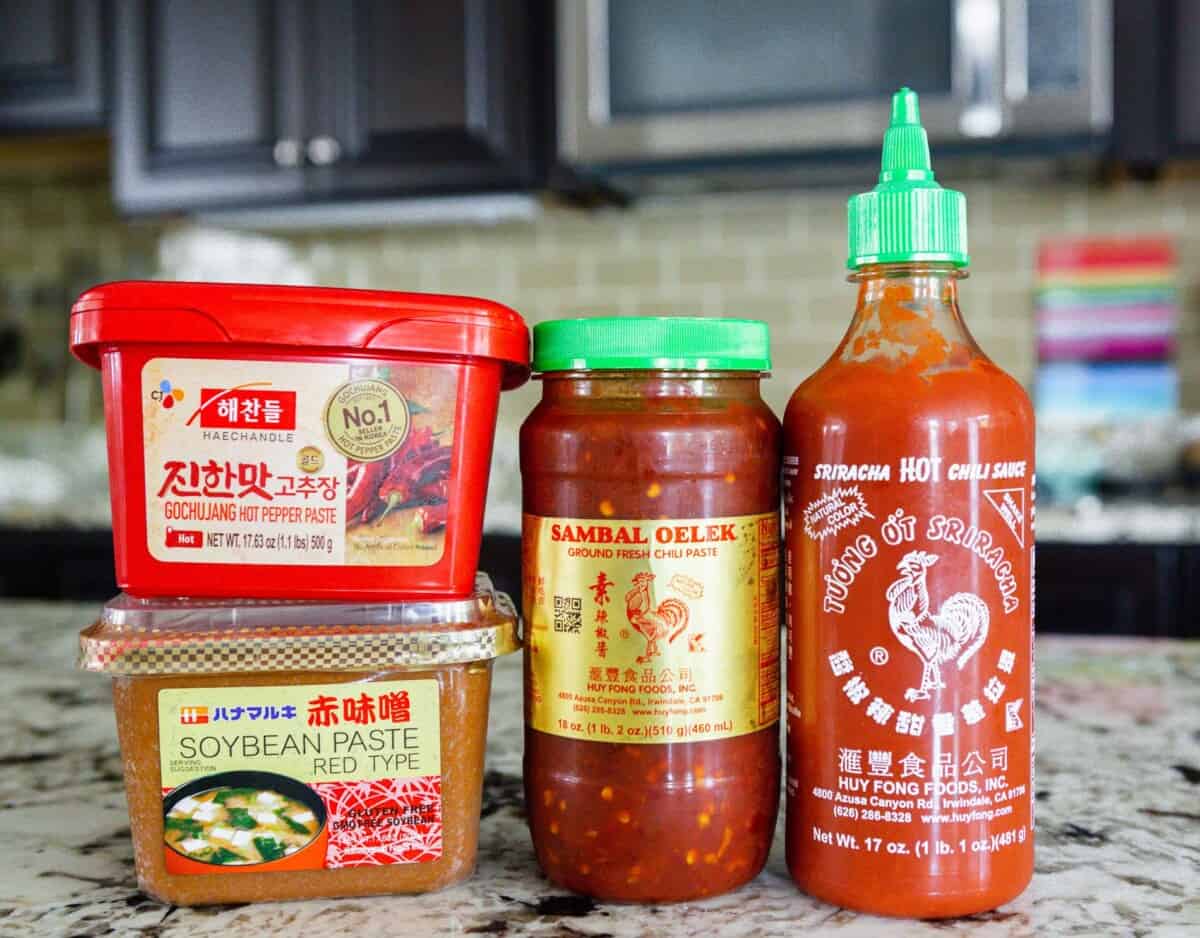
Chili crisp
Specifically, the Lao Gan Ma chili crisp. The OG chili crisp. Sure, TJ’s has their own garlic chili crisp but it DOES NOT compare to the OG Lao Gan Ma chili crisp!
The LGA chili crisp is iconic and it’s like *the* brand to use and buy. It has so much unique flavor and a lot of texture, yet it’s not really that spicy (gives a slight kick but not like burn your mouth kind of feel), and it has that salty, anise, beany taste to it as well.
You can literally put this on EVERYTHING. My favorite is to put it on ramen but I literally mix it into everything – eggs, fried rice, you name it.
Gochujang
If I’m going for a more Korean-flavored sauce dish, I will usually add a small amount of gochujang in the sauce.
There is a huge misconception that gochujang can be a replacement for red chili powder in kimchi. In fact, I wrote about that in my homemade kimchi post so you’ll want to check it out.
Gochujang is a staple in Korean households and I like using it for the heat and flavor. It’s a thick paste that typically comes in a tub, like you see above. When you go to the Asian grocery store, typically a Korean one, there is basically an entire aisle dedicated to gochujang and you will be amazed at how many different kinds there are. The brand you see above is typically what I buy because it’s what I know. Be careful, there are heat levels on it. I have bought the mild before but I accidentally grabbed the hot this time and it is definitely hot, so I don’t put as much in sauces as I usually would the mild.
Miso paste
If you want some umami flavor and your guests/family trying to pinpoint that flavor in your dish…miso paste!
It’s a Japanese seasoning product made of fermented soy beans. You most often see/have it in miso soup but adding it to your sauces really amps up the flavor. It is pretty salty so a little goes a long way. If I’m using miso in a sauce, I try to add more water to the sauce so it’s not too salty.
Like all sauces and pastes, there is a wide variety and it can be overwhelming on which to get. There’s white and red. There’s sweet, mild, and salty. There’s rice, barley, soybean. There’s also different regions.
It’s really a lot. Nami explains it best in her miso post here, but what I typically grab is red miso which is usually soybean and salty.
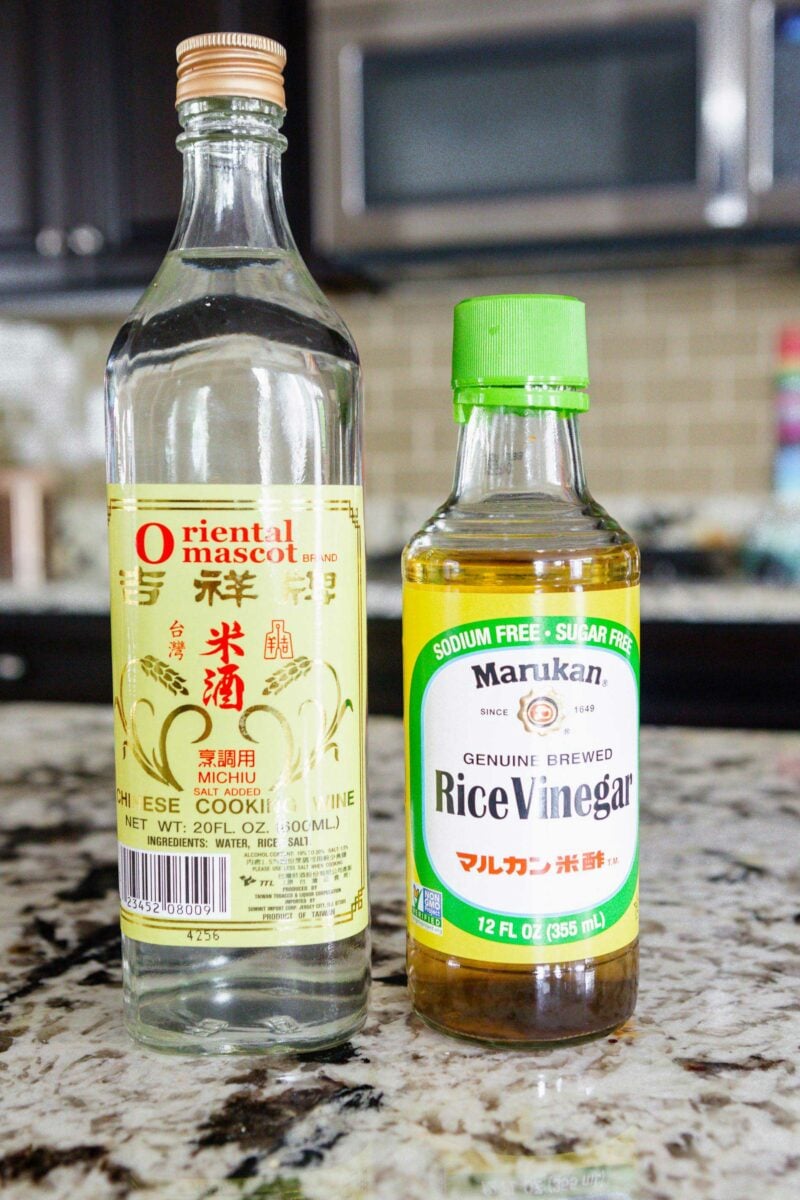
Wines and Vinegars
Shaoxing/Mijiu/Michiu
This is about to get confusing.
Shaoxing, mijiu/michiu are rice wines and they’re used in cooking but more readily known for marinating to tenderize meats and also take away that meaty/gamey taste. My mom used it most often by marinating in cornstarch, soy sauce, and mijiu.
Shaoxing is darker and a more complex, deeper taste. I rarely have this in my cabinet but something I wanted to bring up since I know if you go to an Asian market, you will see it and wonder.
I typically always have the clear white wine, mijiu/michiu, and the bottle you see above is typically what I always have and buy. It’s the one my mom always had too. It lasts quite a while.
Rice wines are different than regular wine in cooking. You know how they say “use a wine you’d drink” in regular cooking (like a bottle of white wine)? Well, you don’t do that here, and if you try to drink it, you will know why LOL
Everyone asks what substitute there is for rice wine for a variety of reasons, usually because you don’t drink alcohol or because you can’t find it.
There really isn’t a substitute because of rice wine’s complex flavor. If you must, you can substitute a dry sherry, but there truly is no substitute. This isn’t Asian people being snobby, it’s just matter of fact that you can’t replicate rice wine’s flavor with anything else.
Another thing is people often want to substitute Chinese rice wine with Mirin, which is a Japanese rice wine. It is not the same, at all. Japanese mirin is sweet and has a very distinct flavor and really should be saved for Japanese dishes/cooking.
Rice Vinegar
Rice vinegar, or rice wine vinegar (I use it interchangeably on the blog and it’s sometimes confusing), is most commonly like white vinegar in American cooking. It brings acidity and that vinegar-y taste to a sauce or dish. Rice vinegar is slightly milder than white vinegar.
There’s seasoned and unseasoned versions of it. I typically buy the seasoned. The difference is that the seasoned one has added seasonings in it like sugar and salt.
Spices, herbs, powders, and other add-ins
Five-spice powder
Hands down this is one of those quintessential ingredients in Taiwanese and Chinese cooking. It is heavily used in braises and stews, like my braised minced pork recipe. The five spice powder is a spice blend combination of star anise, fennel seed, cinnamon, cloves, and Sichuan peppercorns. Variations do occur but in general those are the five spices.
It smells SOOO good and I love the warmth it creates in a dish.
Fried shallots
Okay, technically not a sauce but I love adding these fried shallots into stir fries because of the incredible amount of flavor they have and they also have really good texture!
Honey
A classic sweetener I like adding to my sauces to help thicken and caramelize sauces, and of course, bring a bit of sweetness to the dish.
Brown sugar or granulated/white sugar
Like I mentioned above, I typically suggest using brown sugar to create sweet soy sauce if you can’t find sweet soy sauce in your grocery store. It’s untraditional, for sure, but a great substitute.
I like the rich flavor of brown sugar from the molasses so I will often choose to use brown sugar over honey when I make sauces, but again, it also depends on what flavor profile I’m digging that day.
Taiwanese households also keep “rock sugar” in their pantry. It’s kind of like sugar cubes but they’re clear and less uniform in shape. We use them in teas and my mom has used them in cooking too when she isn’t using white sugar. It’s like a subtle sweetness that isn’t overpowering.
Ginger
Fresh ginger root is commonly used in Taiwanese and Chinese cooking. They love the freshness and bite.
Fresh Thai basil
While this is Thai, Taiwanese and Chinese use it in the kitchen all the time. We tend to toss them in dishes at the very end to give it that fragrant oomph. The famous Three Cup Chicken heavily uses Thai basil.
Cilantro
You know how much I hate this herb but Taiwanese LOVE it, including my entire family that can eat cilantro without it tasting like soap. I guess that gene skipped me. Seriously, most Taiwanese and Chinese dishes finish off the dish with a heavy sprinkle of cilantro. I can basically never avoid it, lol
Cornstarch
This is actually one of my favorite ingredients. I use it so often in sauces as a thickener but I also love using it to crisp ingredients up (tofu, beef).
Sometimes I create a cornstarch slurry (1:1 ratio of cornstarch and water) to thicken sauces, or I’ll add the cornstarch straight into the sauce and whisk it all together.
Additionally, we use cornstarch, cooking wine, and soy sauce together to velvet our meats. It’s a technique that many Chinese chefs in the kitchen use but many home cooks do it too. I watched my mom do it often. What it does is it helps give the meat a silky and velvety texture that you find when you eat at a Chinese restaurant and wonder how they get the meat so silky smooth!
Dried shiitake mushrooms
My parents always brought home a giant bag of dried shiitake mushrooms from Taiwan because of how often it’s used in recipes. It gives the dish a lot of flavor and they’re so easy to use and don’t take up a lot of space because they’re dried.
To reconstitute them, I just soak them in hot water and because of its spongy texture, it soaks up the water and becomes soft again. You can then chop them up to add to soups or stir fries.
White pepper
While you do find black ground pepper in Taiwanese and Chinese kitchens, white pepper is far more popular. We prefer it for its unique flavor (I find it a bit spicier and it definitely tastes different – in a good way) and so it doesn’t add dark specks to light dishes.
How to create sauces
Generally speaking, you have a base of soy sauce, add in a little sweetener, a bit of acidity, and some toastiness and spice.
Here are some homemade sauces I make all the time with these staple ingredients:
- Pan-Fried Sesame Tofu Sauce
- Teriyaki Sauce
- Spicy Chili ‘Lava’ Sauce (probably my favorite and most often made)
- Sugared Soy Sauce
- Bulgogi Kimchi Burger
I hope this was helpful and stay tuned for my post all about noodles!

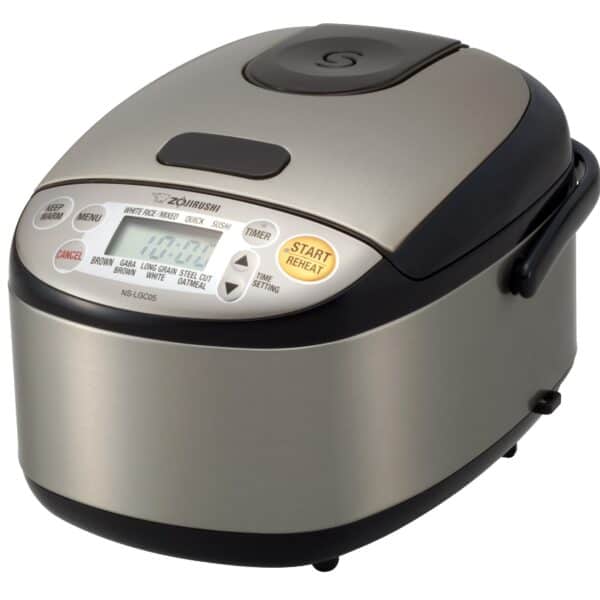
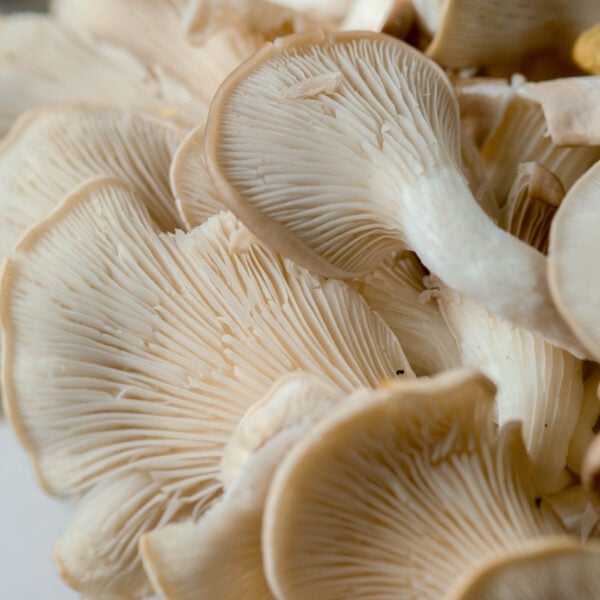
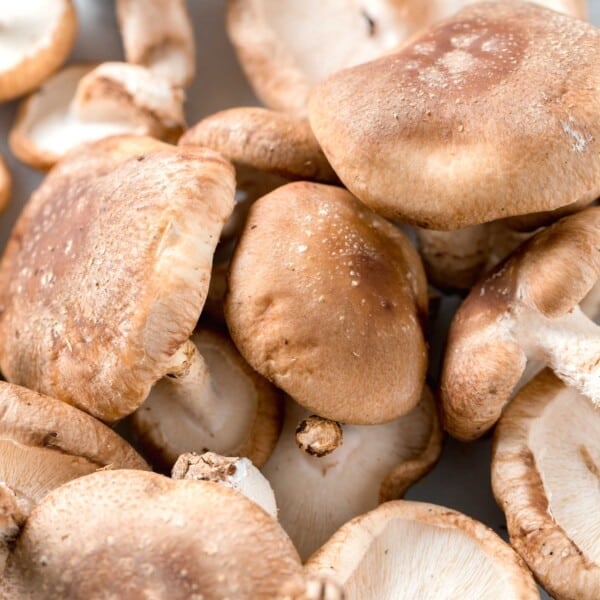
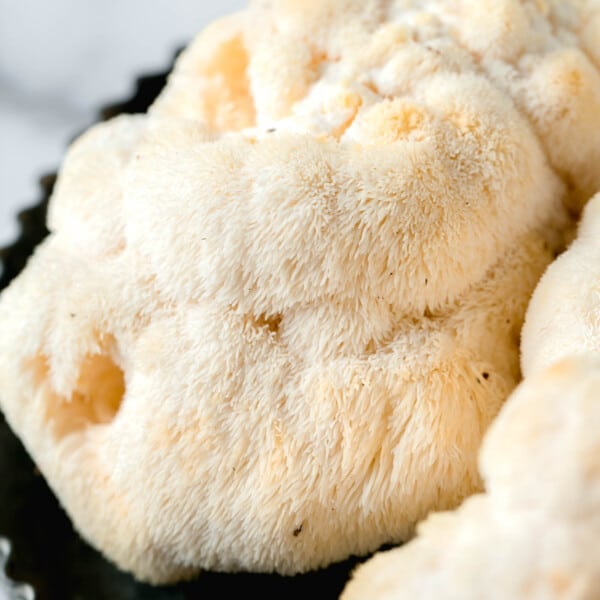







once again Julie, your information was such a motivator that I wanted to go right out to the Asian store and start supplementing my Asian spices. Another 5 🌟 post. I would also like to see some of your recipes for Asian fish.
Thank you for the positive feedback, Randy! I really appreciate it. Recipes for Asian fish…I have this: https://www.tablefortwoblog.com/miso-butter-cod-foil-packets/ and also, this is a recipe from childhood: https://www.tablefortwoblog.com/soy-sauce-and-sugar-salmon-with-white-rice/
ou have a base of soy sauce, add in a little sweetener, a bit of acidity, and some toastiness and spice.
Thank you for this post I learned a lot. I love the chili crisp its my favorite to put in ramen.and the info about soy sauce….going to get and try the bullhead…
I didnt like cilantro until I made this sauce to put in my avocado dip cilantro sauce: makes 1 cup: 4 garlic cubes, 1 1/2 cups (1-1/2 large bunch) cilantro, 1/2 tsp. salt, 1/8 tsp. red pepper, 1/8 tsp. blk pepper, 1 cup olive or avocado oil, blend together
I also think my tastes change with age!
yes! they say tastebuds change every 7 years
Julie, thank you so much for this post!! It’s so informative! I love it!